Land Management Plan - Part 2 Los Padres National Forest Strategy
Land Management Plan - Part 2 Los Padres National Forest Strategy
Land Management Plan - Part 2 Los Padres National Forest Strategy
Create successful ePaper yourself
Turn your PDF publications into a flip-book with our unique Google optimized e-Paper software.
<strong>Land</strong> <strong>Management</strong> <strong>Plan</strong> <strong>Part</strong> 2<br />
<strong>Los</strong> <strong>Padres</strong> <strong>National</strong> <strong>Forest</strong> <strong>Strategy</strong><br />
September 2005<br />
Pozo - La Panza<br />
Theme: A vast rolling chaparral landscape including a remote motorized recreation network<br />
supporting dispersed recreation activities, grazing areas for wild horses and livestock, and private<br />
inholdings characterize this Place.<br />
Setting: The low, dissected hills and mountains of the<br />
La Panza Range dominate the Pozo/La Panza Place.<br />
Most of the Place is readily accessible either by the<br />
historic Pozo-La Panza Road (that passes through the<br />
area from east to west), or by the Navajo Road that<br />
takes off from California State Highway 58 and runs<br />
south until it meets the Pozo-La Panza Road. The<br />
Pozo/La Panza Road provides the only motorized<br />
access to the north end of the Machesna Mountain<br />
Wilderness.<br />
This is a largely chaparral-covered landscape with<br />
scattered blue oak woodlands, gray pines, and<br />
occasional annual grasslands. Several threatened,<br />
endangered and sensitive plant and animal species<br />
reside here including the dwarf calycadenia (Calycadenia villosa), Camatta Canyon amole<br />
(Chlorogalum purpureum reductum), Parish's checkerbloom (Sidalcea hickmanii ssp. parishii),<br />
Santa Margarita manzanita (Arctostaphylos pilosula pilosula), peregrine falcon and the<br />
California condor. Water is scarce except for several springs that are vital to both wildlife and<br />
livestock.<br />
This area is best known for its variety of OHV opportunities that require advanced skill levels.<br />
Visitors from coastal areas, especially San Luis Obispo and Arroyo Grande, heavily use OHV<br />
routes. In addition to motorized use, the area supports recreation uses such as mining, hunting,<br />
mountain biking and the running of hounds. There are four grazing allotments and a portion of<br />
the Black Mountain Wildhorse Territory. The Place supports special-uses, such as power lines,<br />
apiaries, and filming<br />
locations. Much of the area<br />
is a historic gold mining<br />
district as evidenced by<br />
scattered abandoned mines.<br />
The variety and intensities of<br />
use in this Place create<br />
conflicts and management<br />
challenges for recreation and<br />
permitted activities.<br />
Special Interest Area:<br />
Page 70<br />
• Camatta (new) 55<br />
acres
















